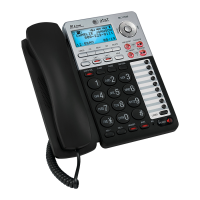
Do you have a question about the AT&T ML17939 and is the answer not in the manual?
| Model Number | ML17939 |
|---|---|
| Number of Lines | 1 |
| Answering System | Digital |
| Caller ID | Yes |
| Call Waiting | Yes |
| Speakerphone | Yes |
| Memory Dialing | Yes |
| Display | LCD |
| Phonebook Capacity | 50 |
| Headset Jack | Yes |
| DECT 6.0 Technology | Yes |
| Handset Locator | Yes |
| Volume Control | Yes |
| Power Source | AC Adapter |
| Redial | Yes |
Instructions for preparing the telephone for installation, including DSL filter advice.
Overview of telephone buttons and their functions for quick access.
Guide on installing backup batteries for power failure protection.
Steps for connecting and setting up the telephone base, lines, and handset.
Configure ringer volume, melody, display language, backlight, date/time, key tone, and scroll rate.
Adjust primary line, auto line selection, auto speaker, preferred mode, and dialing options.
Setup for answer on/off, announcements, call screening, message length, and remote codes.
Manage visual indicators for new voicemail messages and COVM settings.
Making, answering, ending calls, and using speakerphone, handset, or headset.
Features like volume control, flash/call waiting, mute, hold, and conference calls.
Information on the 18 speed dial locations and how to access them.
Steps for storing, reviewing, editing, and dialing speed dial numbers.
Details on memory capacity, character chart, and search features.
Creating, reviewing, searching, editing, copying, and deleting directory entries.
Explanation of Caller ID and Caller ID with Call Waiting services.
How the call log works, viewing entries, and memory match functionality.
Managing dialing options, call history entries, and saving entries to directory/speed dial.
Distinguishing between built-in answering system and provider voicemail.
Managing message capacity, playback, deletion, memos, and remote access.
Visual and audible cues for system status, messages, and errors.
Reference for messages displayed on the telephone screen.
Solutions for common operational issues with the telephone.
Guidelines for maintaining the telephone's appearance and functionality.
Essential safety guidelines to prevent injury, fire, or electric shock.
Regulatory compliance, product identifiers, and network connection rules.
Information on product warranty coverage, service, and exclusions.
Details on operating temperature, power adapter, and battery requirements.